Ideal Voltage and Current Source Explained

An ideal voltage source is a voltage source that supplies constant voltage to a circuit despite the current which the circuit draws.
This means that despite the resistance which a load may be in a circuit, the source will still provide constant and steady voltage.
An ideal voltage source has the following characterstic that allows it to act as a 100% efficient source of voltage: it has zero internal resistance.
When an ideal voltage source has zero internal resistance, it can drop all of its voltage perfectly across a load in a circuit. Being that the source has zero internal resistance, none of the power is wasted due to internal resistance. The ideal voltage source can 100% efficiently drop all of its voltage across a load. This is proven by ohm's law. According to ohm's law, voltage is dropped across circuit elements according to the formula, V=IR. If a voltage source has zero internal resistance, it can drop all voltage across a load and none will be wasted internally. This is 100% power efficiency and this is an ideal voltage source.
Being that an ideal voltage source has zero internal resistance, and, thus, 100% efficiency to outputting all of its voltage to a load due to perfect
voltage division, its voltage ouput to a load is steady and constant
and doesn't fluctuate even if load resistance values change. Thus, the voltage output by an an ideal voltage source looks like:
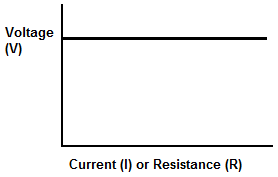
Let's examine the following circuit below:
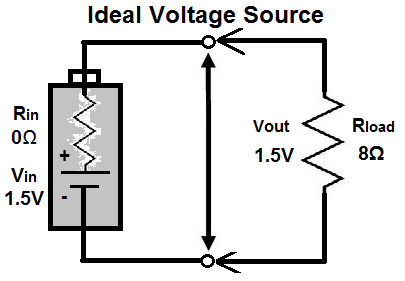
RIN, the internal resistance of the battery, is 0Ω. This demonstrates that this battery is an ideal voltage. The resistance load which is in the circuit is 8Ω. The
load, therefore, receives all of the 1.5V of the battery.
This would be an ideal voltage source. However, this does not and cannot exist in real life, because all voltage sources, such as batteries, will have some type internal resistance. Due to voltage sources being physical objects, they will always have some degree of internal resistance which will make some of the voltage be wasted. Some have lower resistance than others, but all will have some resistance.
Real voltage sources, therefore, do have some resistance. This can vary from as little as a few thousandth of an ohm to as much as several ohms, such as 35Ω. Check out the article on Internal Resistance to learn more. This resistance makes the voltage source no longer act ideal. All of its voltage now will not be dropped across the load. Due to the internal resistance, the battery will drop some voltage across itself, leading to wasted power. The lower the resistance, the less wasted power.
Let's examine the same above circuit now with a voltage source with real conditions (some internal resistance):

You see now how this circuit differs from the ideal one. Some power is wasted and there is not 100% efficiency. Because RIN is now 1Ω, there is no longer perfect conditions.
Although ideal voltage sources are impossible to make because all types have some internal resistance, the closer we can get a voltage source to ideal conditions, the more
efficient the source will be in supplying voltage with little power waste. So we use ideal sources as models and try to make real components as close to them as possible.
Ideal Current Source
An ideal current source is a current source that supplies constant current to a circuit despite the voltage dropped in the circuit.
Unlike an ideal voltage source, an ideal current source has the following characterstic that allows it to act as a 100% efficient source of current: it has infinite internal resistance.
Why Does a Current Source Have Infinite Internal Resistance?
The reason why a current source has infinite internal resistance will now be explained.
Before we do that, realize that the job of a power source, whether voltage or current, is to supply a load in a circuit. It is the power source for a load so that a load can be turned on. Thus, we want to ideally supply 100% power from the source to the load. This is power transfer. In order to supply 100% power from the source to the load, we must allocate the resistances in the circuit appropriately so that the load receives 100% power. This is called current division. Current always takes the path of least resistance. Thus, in order for current to go to the path of least resistance, we must set up the source and load so that the source has much higher resistance than the load. This will ensure that the current travels from source to load. This is why we construct the ideal current source to have infinite internal resistance. This will ensure that current will flow out of it and take the path of least resistance, which will be the load, since the load will not have infinite internal resistance.
When the current source has infinite internal resistance, the output current from the source will not change despite changes in resistance value from the load. The current will
always want to escape out of its infinite resistance to a lower resistance. This produces a current output graph below of an ideal current source:
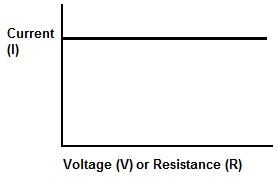
Let's examine a circuit with an ideal current source shown below:
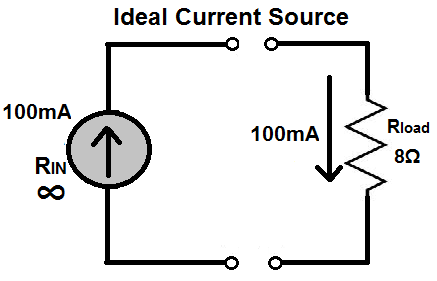
Because the current source has infinite impedance, the current from the source looks to escape and go to through a path of lesser resistance, which is the 8Ω load. All of the current from the current source (100mA) flows through the 8Ω resistor load.
Now let's examine the circuit with a real current source shown below:
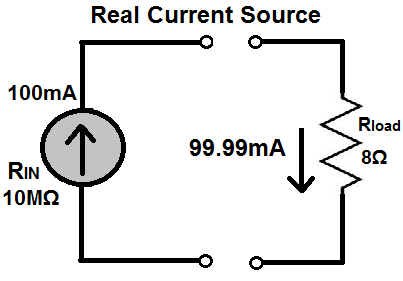
This current source has 10MΩ, which is high enough to give enough a very close current to full value of the current source, 100mA, however, it will still be less. This is because the internal resistance of the current source will still eat up some of the current and lead to current waste.
Though ideal current sources do not exist, they serve as a model so that we can construct current sources (real) that mimic as close as possible the characteristics of an ideal
current source.
Related Resources
If you have any questions or comments about this topic, please join our
forum here.
